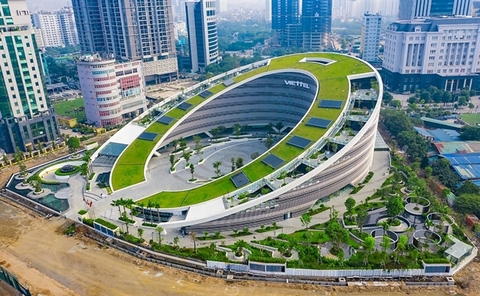
A construction site in Hà Nội. The country still has a lot of ground to cover to reduce its building greenhouse emissions. — Photo kinhtedothi.vn
Việt Nam still has a long way to go in reducing its greenhouse emissions, despite making significant progress in the development of green buildings in recent decades, said deputy minister of construction Nguyễn Tường Văn at a conference in Hà Nội yesterday.
According to a report from the Ministry of Construction (MoC), by the end of the second quarter of 2023, approximately 300 green buildings have been assessed and certified using standards such as Lotus (VGBC), Edge (IFC-WB), LEED (U.S. Green Building Council), and Green Mark (Singapore), with a total floor area of around 7 million square metres.
The Southeast Asian country currently ranks 28th in the world in terms of the number of LEED-certified buildings.
Văn said, however, the figure is still a relatively modest one in comparison to the number of buildings constructed and in operation across the country. There is still much to do to improve energy and resource efficiency. In addition, the country has no buildings designed, constructed or managed in a way that can meet net-zero emission objectives.
The deputy minister said major obstacles to the development of green buildings in Việt Nam include the current economic downturn, especially in the property market and difficulties in accessing funding for green projects.
To make matters worse, the market faces an acute shortage of skilled workers in the planning, design, construction and management of green buildings. As of now, there are still no regulations to force the use of green building materials and energy-saving products in the market.
Nguyễn Công Thịnh, deputy head of the Department of Science, Technology, and Environment under the MoC said it's high time the government implemented strong sanctions to ensure projects are energy efficient, instead of hoping developers to take action voluntarily.
He added there are still no action plans and programmes at both the central and local government levels. Awareness remained low while available human and financial resources continued to prove inadequate, making the country's objectives in the development of green building difficult to meet.
Thịnh said the government should introduce incentives for businesses and set up preferential funds for those who are interested in investing in green building development.
Hoàng Cao Thăng, deputy director of the Hà Nội Department of Construction said resource mobilisation, science and technology are all vital parts of the development of green infrastructure, waste management and treatment.
He proposed the city must start the renovation of old and low-income residential areas with a focus on leveraging modern green technologies.
Patrick Liu, CEO of Green Building Council said the benefits of green buildings are many, especially for the end-users. The main challenges, however, lie with raising awareness and implementing financial incentives, including tax benefits for developers and consumers.
Việt Nam has set a target to have 80 certified green buildings nationwide in 2025 and 150 in 2030 as part of the government's commitment made at COP26 to reach net-zero emissions by 2050. — VNS